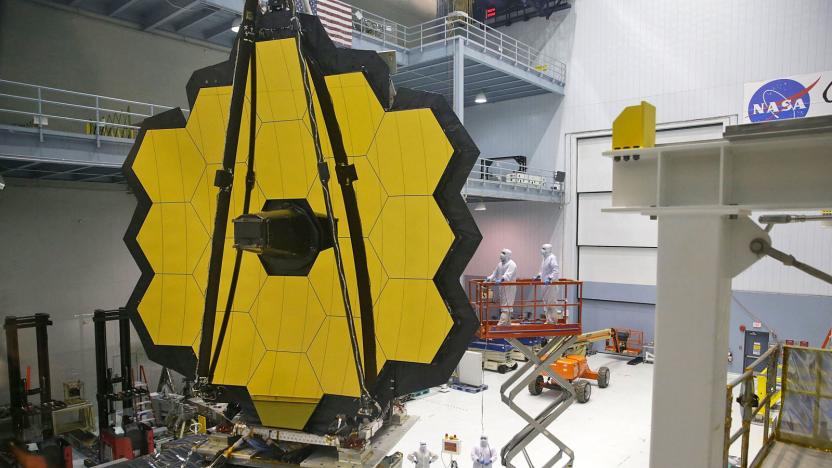TL17WEBB
Latest

Lights out on a ghostly James Webb Space Telescope inspection
The James Webb Space Telescope (JWST) might be the most important scientific instrument ever developed. It'll peer back in time over 13 billion years to the early universe and look for signs of life around the recently discovered TRAPPIST-1 planetary system.

NASA will resume testing its Hubble successor this month
One of NASA's biggest victories last year was the $8.7 billion James Webb Space Telescope's completion. And now the aeronautics agency is set to resume vibration testing for the instrument. These tests aim to replicate the conditions it will encounter before lift-off to "ensure that functionality is not impaired by severe launch and landing environments," according to NASA.

NASA dominated space and social media in 2016
"We all have a thirst for wonder," American astronomer Carl Sagan wrote in his sci-fi novel Contact. "It's a deeply human quality." And it's partly thanks to this "thirst" that NASA had the space game on lock this year, even though it doesn't have access to as much money as it used to. The agency stepped into 2016 armed with $19.3 billion in government funding. Yes, that's almost a $1 billion more than what the administration originally asked for, but it's also significantly lower than NASA's budget in previous years, when adjusted for inflation.

NASA has completed the $8.7 billion James Webb space telescope
The Hubble Space Telescope has given humanity unprecedented glimpses into the universe, but it will soon be replaced by a far more powerful model. NASA administrator Charles Bolden unveiled the completed $8.8 billion James Webb Space Telescope (JWST), which will be able to see the universe as it was 13 billion years ago. It's equipped with a 21-foot, gold-coated mirror array that can collect seven times more light than Hubble and scan the infrared spectrum to see through dust. "We've done two decades of innovation and hard work, and this is the result," project scientist John Mather says.

NASA installs the first mirror on the Hubble's replacement
NASA announced on Wednesday that it had successfully installed the first of 18 mirrors on the new James Webb space telescope. The work took place at NASA's Goddard Space Flight Center in Greenbelt, Maryland earlier this week.

James Webb Space Telescope ready for its wings, on track for 2018 launch
What's a spacecraft need wings for? Packaging, of course. The James Webb Space telescope relies on a 21 foot diameter backplane mirror to steady it, but the assembly needs to fit inside of a 16.5 foot fairing to ride the rocket to the stars. A tight fit, to say the least. Fortunately, NASA technicians have just finished the mirror backplate support structure, a folding wing assembly designed with to safely collapse the beryllium mirror during flight, and expand it again in orbit. "This is another milestone that helps move Webb closer to its launch date in 2018," remarked Geoff Yoder, the program's director. Now that the wing assembly is finished, the team can focus on the support fixture for the instrument model, which will complete major construction and allow technicians to connect the finished pieces. We'll miss old Hubble, sure, but we're happy to see its successor pulling things together all the same.

NASA to launch Hubble space telescope successor in 2018, will clean its room later
You know you're going to miss the Hubble Space Telescope once ceases operation and they let it simply burn up in orbit. But don't cry, dry your eye, the National Aeronautics and Space Administration has announced plans to put its successor, the James Webb Space Telescope, in orbit in 2018. The telescope, which will be 100 times more sensitive than the Hubble, faced being cut completely by a Congressional subcommittee earlier this year as a result of budget constraints given its $8.8 billion price tag. After much Capital Hill grilling over the project being billions over budget, NASA has moved is scheduled launch -- initially set for 2013 -- to October of 2018. Although not the best news, it'll still get up there and you can hug your Hubble plushie tightly tonight knowing distant worlds will be that much closer.

NASA shows off James Webb Space Telescope, the Hubble successor
With Hubble slowly winding down after years of service, NASA has now taken to talking up the telescope's successor, even going so far as to take a full-scale model of the James Webb Space Telescope (JWST) on the road. Currently on display outside the Smithsonian National Air and Space Museum in Washington, D.C., the model measures an impressive 80 feet long and 40 feet high, which you'll have to be content with until the actual telescope launches in June 2013 at a cost of $4.5 billion. Once deployed, the telescope will sit some 1.5 million kilometers (or 930,000 miles) from Earth, and be able to peer far deeper into space than Hubble is able to, thanks in large part to the JWST's ginormous foldable mirror (almost three times bigger than Hubble's). If you can't make it to the Smithsonian to check out the model, you can at least get a better look at it in the gallery of images below courtesy of NASA. %Gallery-3077%






